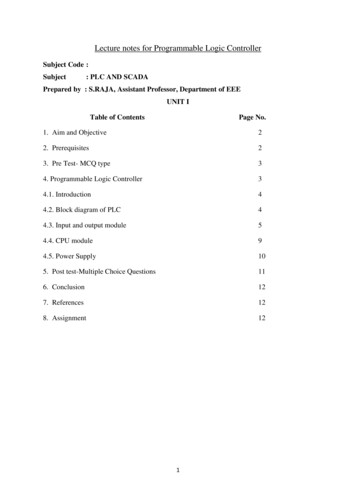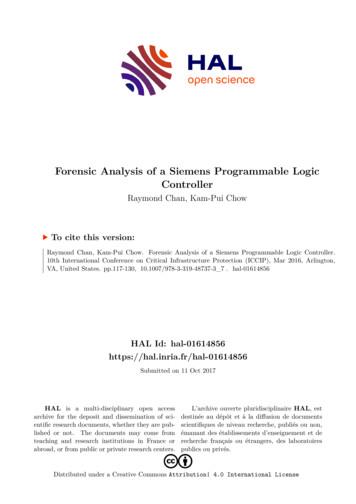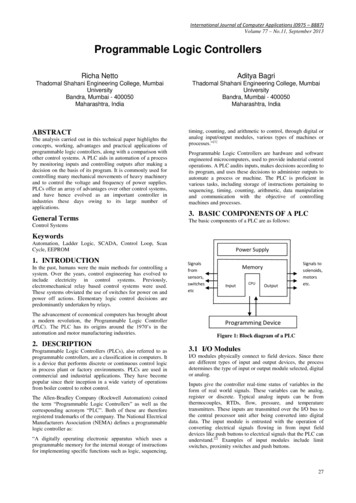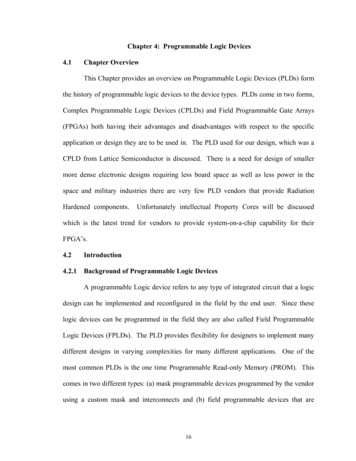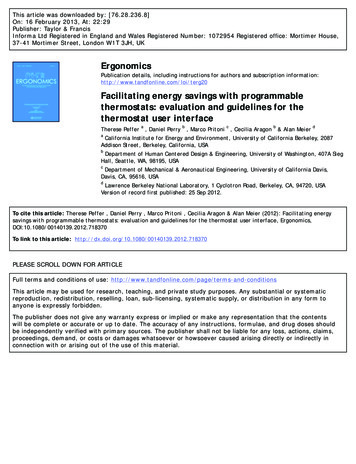
Transcription
This article was downloaded by: [76.28.236.8]On: 16 February 2013, At: 22:29Publisher: Taylor & FrancisInforma Ltd Registered in England and Wales Registered Number: 1072954 Registered office: Mortimer House,37-41 Mortimer Street, London W1T 3JH, UKErgonomicsPublication details, including instructions for authors and subscription acilitating energy savings with programmablethermostats: evaluation and guidelines for thethermostat user interfaceabcbTherese Peffer , Daniel Perry , Marco Pritoni , Cecilia Aragon & Alan MeierdaCalifornia Institute for Energy and Environment, University of California Berkeley, 2087Addison Street, Berkeley, California, USAbDepartment of Human Centered Design & Engineering, University of Washington, 407A SiegHall, Seattle, WA, 98195, USAcDepartment of Mechanical & Aeronautical Engineering, University of California Davis,Davis, CA, 95616, USAdLawrence Berkeley National Laboratory, 1 Cyclotron Road, Berkeley, CA, 94720, USAVersion of record first published: 25 Sep 2012.To cite this article: Therese Peffer , Daniel Perry , Marco Pritoni , Cecilia Aragon & Alan Meier (2012): Facilitating energysavings with programmable thermostats: evaluation and guidelines for the thermostat user interface, Ergonomics,DOI:10.1080/00140139.2012.718370To link to this article: SE SCROLL DOWN FOR ARTICLEFull terms and conditions of use: nsThis article may be used for research, teaching, and private study purposes. Any substantial or systematicreproduction, redistribution, reselling, loan, sub-licensing, systematic supply, or distribution in any form toanyone is expressly forbidden.The publisher does not give any warranty express or implied or make any representation that the contentswill be complete or accurate or up to date. The accuracy of any instructions, formulae, and drug doses shouldbe independently verified with primary sources. The publisher shall not be liable for any loss, actions, claims,proceedings, demand, or costs or damages whatsoever or howsoever caused arising directly or indirectly inconnection with or arising out of the use of this material.
Ergonomics2012, 1–17, iFirst articleFacilitating energy savings with programmable thermostats: evaluation and guidelines for thethermostat user interfaceTherese Peffera*, Daniel Perryb, Marco Pritonic, Cecilia Aragonb and Alan MeierdaCalifornia Institute for Energy and Environment, University of California Berkeley, 2087 Addison Street, Berkeley, California,USA; bDepartment of Human Centered Design & Engineering, University of Washington, 407A Sieg Hall, Seattle, WA 98195,USA; cDepartment of Mechanical & Aeronautical Engineering, University of California Davis, Davis, CA 95616, USA; dLawrenceBerkeley National Laboratory, 1 Cyclotron Road, Berkeley, CA 94720, USADownloaded by [76.28.236.8] at 22:29 16 February 2013(Received 30 September 2011; final version received 1 August 2012)Thermostats control heating and cooling in homes – representing a major part of domestic energy use – yet,poor ergonomics of these devices has thwarted efforts to reduce energy consumption. Theoretically,programmable thermostats can reduce energy by 5–15%, but in practice little to no savings compared tomanual thermostats are found. Several studies have found that programmable thermostats are not installedproperly, are generally misunderstood and have poor usability. After conducting a usability study ofprogrammable thermostats, we reviewed several guidelines from ergonomics, general device usability, computer–human interfaces and building control sources. We analysed the characteristics of thermostats that enabled orhindered successfully completing tasks and in a timely manner. Subjects had higher success rates with thermostatdisplays with positive examples of guidelines, such as visibility of possible actions, consistency and standards,and feedback. We suggested other guidelines that seemed missing, such as navigation cues, clear hierarchy andsimple decision paths.Practitioner Summary: Our evaluation of a usability test of five residential programmable thermostats led to thedevelopment of a comprehensive set of specific guidelines for thermostat design including visibility of possibleactions, consistency, standards, simple decision paths and clear hierarchy. Improving the usability of thermostatsmay facilitate energy savings.Keywords: thermostat; user interface; energy; usability; heuristic evaluation; residential1.IntroductionMany energy efficient items of equipment or energy reduction measures save energy from the time they are installed,such as efficient refrigerators or building insulation; however, others require the active participation of an informedhuman. Programmable thermostats (that can automatically relax temperatures at night or during unoccupiedperiods) have been promoted all over the world to save energy used to heat and/or cool people’s homes. In the US,where nearly two-thirds (64%) of the residential heating systems use central air, energy for residential heating andcooling amounts to 9% of the total primary energy use (Energy Information Administration (EIA) 2010, USDepartment of Energy (DOE) 2011a,b). A widely used rule of thumb is a savings of 1.8% per degree C (1% perdegree F) for an eight-hour adjustment (Nelson and MacArthur 1978). Yet, programmable thermostats have largelyfailed to save energy due to poor ergonomics. A recent literature review (Peffer et al. 2011) uncovered many reasons:improper installation (e.g. mounted sideways, in dimly lit corridors, too high/too low), poor interface (e.g. buttonstoo small, icons/terms not understood) and misunderstanding of how thermostats work in particular and howheating/cooling systems work in general.The ergonomics of a thermostat involves understanding its context to analyse the demands placed on the user’scapabilities during its use. A typical residential thermostat controls the heating and/or cooling equipment, providesa user interface for the occupant to read current status and adjust the control, and contains at minimum atemperature sensor to provide control feedback. The thermostat is typically mounted on a wall and wired to theheating, cooling and/or ventilation system; ideally, this wall is an interior wall insulated from outdoor conditionsand centrally located in the house. The de facto standard in the US for placement of the thermostat on the wall is1.524 m (60 inches) from the floor. The physical location alone not only affects the functionality of the device (due*Corresponding author. Email: therese.peffer@uc-ciee.orgISSN 0014-0139 print/ISSN 1366-5847 onlineÓ 2012 Taylor & 370http://www.tandfonline.com
Downloaded by [76.28.236.8] at 22:29 16 February 20132T. Peffer et al.to the temperature sensor) but several user capabilities, such as reach and vision. In our literature review, we foundexamples of programmable thermostats located in inaccessible places (e.g. behind furniture), turned sideways (i.e. toaccommodate the aspect dimensions of the previous thermostat so the users did not have to repaint the wall), toohigh or too low to read/access easily, and in dimly lit corridors, precluding visibility.The human factors of the thermostat also include the user interface, which impacts human vision,communication, cognition and dexterity. The basic thermostat interface needs to: allow the user to provide acomfortable temperature (whether heating or cooling), set a schedule for convenience (e.g. heat before getting out ofbed in the morning) and for energy savings (e.g. turn off heat/cool systems when no one is at home or when one isgoing out for a few hours or several days; adjust temperatures at night to reduce heating and cooling).Modern programmable thermostats are following two other consumer electronic trends: from using an analoguedisplay to digital (and often from graphic to numeric display) and from mechanical operation (e.g. knobs, sliders) toelectronic (e.g. push buttons, touchscreen). In addition, programmable thermostats are increasingly complex,beyond the base features of setting start and end times for desired temperatures for the day, and days of the week.Today’s programmable thermostats have more control features and display parameters (e.g. status of filter andbattery, amount of energy consumed).In general, programmable thermostats do not have much market penetration in the US and have notconclusively demonstrated energy savings. Although programmable thermostats have been available for morethan 30 years, only 30% of US households have installed them (Energy Information Administration (EIA)2005c). Several studies indicate that many people do not use programmable thermostats as designed. Only 55–60% are used to adjust temperatures at night for cooling and heating seasons, respectively (Energy InformationAdministration (EIA) 2005b) (Energy Information Administration (EIA) 2005a). Approximately half are in‘hold’ mode, effectively disabling the programming features (personal correspondence from Raymond Archackito Gaymond Yee on the Carrier thermostat mode summary, Summer 2003). Several studies have indicated nosignificant savings with programmable thermostats (Cross and Judd 1997, Nevius and Pigg 2000, Haiad et al.2004).The US Environmental Protection Agency reviewed many field studies and concluded that consumers were notusing programmable thermostats effectively due to programming difficulties and lack of understanding of termssuch as set point (Harris 2008). As a result, the EPA discontinued the EnergyStar programmable thermostatprogram in December 2009. Indeed, several recent usability tests with thermostats indicate continued problems(Karjalainen 2009, Sauer et al. 2009, Combe et al. 2011, Perry et al. 2011), suggesting that the industry in general hasnot responded to improve these interfaces nor outlined means of testing them with users. (We note that ConsumerReports test thermostats in well-lighted rooms with users sitting down.)While the study of ergonomics specific to thermostats is not new, thermostat manufacturers in general do notseem to have applied this in their design of thermostats. Thirty years ago, Moore and Dartnall (1982) describedissues such as setting the time on programmable thermostats and Dale and Crawshaw (1983) observed the effect offont size and controls. A quick review of modern programmable thermostats indicates that not only have thefindings in these early studies been ignored, but also technology has changed dramatically and the functions haveincreased in complexity. One hypothesis is that in general, industries have grown from product-driven andconsumer-focused to financially-driven (Foroohar 2011); we can only guess that manufacturers typically balk at thecost of design of such a mundane device as a thermostat.We did not find any existing guidelines or heuristics specific to guiding better ergonomics design of residentialprogrammable thermostats. However, many ergonomics textbooks (e.g. Sanders and McCormick 1993) provide thebasics for visual display, cognition and basic controls. More domain-specific are guidelines on human–computerinterfaces. These are applicable to this study because current programmable thermostats may be described asembedded devices – having computer systems that are limited in scope and designed to do dedicated functions. Thehuman–computer interface design realm provides many guidelines, such as on Internet or web interfaces, and evenregarding smart phone interfaces and touchscreens (Nielsen and Molich 1990, Nielsen 1994b, Cooper et al. 2007,Shneiderman and Plaisant 2009). Two guidelines target commercial building controls (Wyon 1997, Bordass et al.2007), and one recent guideline was specifically developed for thermostats for offices (Karjalainen 2008). Many ofthese latter principles are specific to office buildings and not residential settings.This study examines several guidelines and uses them to evaluate user mistakes and success performing taskson several programmable thermostats in a usability test. We use the guidelines in our analysis of the parametersof the thermostats that led to errors and confusion as well as those that led to successful completion. Inevaluating what worked and what was missing, we then developed a new set of guidelines for residentialthermostat interface design.
ErgonomicsDownloaded by [76.28.236.8] at 22:29 16 February 20132.3Methods of evaluating interfacesWe reviewed several guidelines for user interfaces to assess their potential for evaluating programmable thermostats.The first list (Table 1) suggests potentially relevant parameters from a basic ergonomics textbook. These principlesare grouped into those applicable to location, vision, controls and cognitive abilities. While these guidelines may begenerally applied, they are fairly detailed and specific. Many of these guidelines were developed throughmeasurements, testing and observations of humans.Table 2 provides guidelines from general device interface usability (Polson and Lewis 1990, Norman 2002), thecomputer–human interface realm (Nielsen and Molich 1990, Nielsen 1994b, Shneiderman and Plaisant 2009),commercial building controls (Bordass et al. 2007) and commercial building thermostats (Karjalainen 2008). Theseare grouped horizontally as best as possible to see overlap among the guidelines. These guidelines are fairlygenerally applied, and without much detail. The next few paragraphs describe the various guidelines.The ergonomics guidelines have more specifics regarding the ‘how’ of interface design – where located for bestreach and vision, what kind of display is best for the type of task and the size and type of font. The other guidelinesare more heuristic in nature in providing general design guidance.Norman, Polson and Lewis provide general device usability guidelines. Norman discusses natural mappingsbetween the real world and how users think. Polson and Lewis describe attributes of ‘walk-up-and-use’ applications,which we find particularly appropriate to residential thermostats (Polson and Lewis 1990).The Shneiderman and Plaisant (2009) and Nielsen and Molich (1990) user interface design guidelines seemapplicable to embedded devices (e.g. visible system status, use of conventions and standards, and minimising errors).Limitations of embedded devices such as programmable thermostats as compared to general-purpose computersinclude limited screen size and dedicated functions (to reach a certain state). This limits the ability of the user to fullyexplore or gather data more freely. For example, many programmable thermostats would not be able to support thehelp function and wizards typical of most computer software programs.Bordass et al. (2007) describe end use requirements for more usable controls commonly found in commercialbuildings (such as lighting, fans, windows and thermostats). The Bordass et al. (2007) list provides criteria that arespecific to controls (need for fine control, amount of use), but does not take into account the potential of anembedded device as a control.Karjalainen reviewed six different usability guidelines in developing his own guideline for office thermostats(Karjalainen 2008). He noted in general that the guidelines available do not take into consideration thermal inertia(e.g. the time delay in reaching the desired temperature), psychological, behavioural and physiological componentsof human thermal comfort, the occupant’s lack of knowledge of how the heating/cooling system works, theoccupant’s false idea of comfortable temperatures (e.g. in practice one’s thermal comfort range is much wider thanan occupant often thinks) and the characteristics of heating and cooling systems. Karjalainen provides severalspecific guidelines for temperature controls, detailing the type of feedback (both controls and room); he alsosuggests providing advice on comfortable room temperatures. Finally, he suggests usability testing as part of thedesign process.Table 1.Relevant parameters from an ergonomics textbook (Sanders and McCormick 1993).LocationVisual displayControl interfaceCognitiveWithin reach for control and within sight on display, sufficiently lighted.Illumination on screen, contrast between content and background, glare, font size and type (segmentedfont vs. dot matrix (fewer errors)). Button and switch size and position. Symbol size.Fixed scale with moving pointer provides rapid clue of approximate quantity (and relative rate of change)and set-in quantity (natural relationship between control and display motions).Compatible/consistent with human expectations (faster learning and reaction time, fewer errors)Spatial compatibility: physical similarity of displays and controls.Movement compatibility: (e.g. up arrow or move to right or clockwise indicates increase)Hierarchy of control (rate/first order vs. higher order control)Push button for discrete information vs. sliding lever or turning knob for transmitting continuousinformationCoding controls: shape, texture, size, location, operational method, colour, labelsPush vs. hold down: feel of resistanceAlpha-numeric display good for identification and small space, also superior to analogue when a precisenumeric value is required and values are not continually changing.Symbolic signs preferable if the code symbol has an already fairly universally established association (norecoding from symbol to words to concept).Easiest to read straight line scale (vs. curved) with moving pointer and control moves the pointer (Heglin1973).
Advice on comfortableroom temperaturesFemales as test users inreal-life situationsInformative helpSimplicity of interfaceAdequate and fast effecton room temperature.Shared temperaturecontrols with heatingand cooling systemsAesthetic designAcceptable defaultsettingsClear way to adjustroom temp.Keep occupants in theloopClear and sufficientfeedback afteradjustmentVisibility, identificationand reachability oftemperature controlsThermostats in officesAesthetic andminimalist designDesign task flow toyield closureError preventionHelp recognise,diagnose, andrecover fromerrorsProvide help anddocumentationFlexibility andefficiency of useCater to universalusabilityPrevent errorsPermit easy reversalof actionsRecognition ratherthan recallMatch betweensystem and the realworldUser control andfreedomConsistency andstandardsVisibility of systemstatusWeb user interfacedesignNielsen and Molich(1990), Nielsen 1994bMinimise short-termmemory loadMake users feel theyare in controlStrive for consistencyWeb user interfacedesignOffer informativefeedbackShneiderman andPlaisant (2009)A compilation of guidelines for more usable interfaces.Karjalainen (2008)Table 2.Simplify taskstructure.Exploit the power ofconstraintsDesign for errorGet the mappingsrightWhen all else fails,standardise.Make mappingsvisible.Make it easy to seepossible actionsUse both knowledgein the world andheadGeneral designNorman (1990)Downloaded by [76.28.236.8] at 22:29 16 February 2013Provide an obviousway to undoactionsRequire as fewchoices as possible.Offer few alternatives.Make availableactions easy todiscriminate.Use identity cuesbetween actionsand user goals.Tolerate at most onehard-tounderstand action.Make the availablerepertoire ofavailable actionssalientWalk up and useinterfacesPolson and Lewis(1990)Not require users tointervene too muchEasy to useNot need to be usedtoo often. Takeinto accountoccasional useWork effectivelyEasy to understandBe located close topoint of need.Give instant, tangiblefeedback toindicate deviceoperationCommercial buildingcontrol designGive rapid feedbackof intended effectBordass et al. (2007)4T. Peffer et al.
Ergonomics5There is much overlap in these guidelines: easy to use and understand, visibility, need for feedback, aesthetics,simplicity and not relying on people’s memory in using the device. The latter two guidelines were designed forcommercial buildings, and thus do not consider context and motivation for using the controls from a residentialperspective (e.g. comfort for guests, saving money).We developed a number of research questions: What can we learn from these guidelines to help evaluate theusability of programmable thermostats – what is useful and what is missing? Specifically, what element(s) of theinterface renders it easier for the subject to complete the task? What features create frustration and prevent taskcompletion?Downloaded by [76.28.236.8] at 22:29 16 February 20133.Research designIn 2010, we conducted a usability study on five commercially-available residential programmable thermostats (threetouchscreen, one web and one button-based – see Table 3), with 31 participants, involving five tasks to evaluatedevice usability and effectiveness. Each subject interacted with two thermostats (one at a time) installed at a heightin the lab typically seen in most US houses. The details of the test and usability metrics developed to evaluate thedevices’ usability and the users’ effectiveness at performing common thermostat tasks are described in Perry et al.(2011). A video recording of each session was used to input numerous categories of data including task completion,time on task, function path (buttons and function interactions), interaction motions (press, slide, hold, etc.),interaction errors and experimenter observations regarding users’ confusion during the task.Table 3.Description of thermostats tons withtouchscreenTouchscreenSmart withtouchscreenWeb portalButton-based programming; full cover over device; user instructions on cover; 7-dayprogramming.Hybrid of touchscreen (primary programming), switches under a cover (heating and coolingcontrols), and button for lighting; 7-day programming; ability to view past energy usage.Touchscreen with black/white display; 7-day programming.Smart WiFi enabled device; full-colour LCD touchscreen; 7-day programming; quick savefunction.Web platform; 7-day programming; synched with wall device.HYBTCHSMTWEBThis study looked at each trial, defined as a subject attempting one of five tasks on a given thermostat, todetermine what parameters led to good versus poor usability. We used the guidelines to categorise these parameters.We analysed each subject’s actions during successfully completed tasks compared with non-completed tasks(included tasks not completed or not successfully completed). In addition, we observed the path length to completeeach task and the total time on task, either to complete the task or ending time when the task was not successfullycompleted.We developed tasks reflecting the typical functions of programmable thermostats. The most important were:ability to turn on/off heating or cooling, temporarily turning up or down heating or cooling, checking the currentand target temperatures, setting time (and changing time at the beginning and end of Daylight Savings Time) andadjusting systems to use less energy when one is away. These tasks were also chosen in consideration of their effecton residential energy consumption. The five tasks finally selected for this study are in Table 4.Table 4.Description of tasks.TasksDescriptionSet heatSet time and day*#Set the thermostat to HEAT mode. (Setting was OFF at the start of the task).Set the thermostat to the current day and time. (The time settings were programmed to Monday at12:00 am for the start of the task.)Identify and read aloud the temperature that the thermostat was set to reach at that current time.Identify and read aloud the temperature that the thermostat was set to reach at a future period(Thursday at 9 pm). (No need to change any settings).Set the thermostat to maintain the same temperature during a five-day period when one is away.Current settingFuture settingVacation/away/holdNote: *not performed on the WEB because time settings could not be modified. #setting the day not performed for the TCH because this requireda code from the manual.
64.T. Peffer et al.Analysis of existing designsDownloaded by [76.28.236.8] at 22:29 16 February 2013This section describes the success rate and time on task for subjects for each thermostat per task. Success refers toaccomplishing the stated goals of the task; time on task marked the ending time for each task, when the subjectstated that he/she was finished (whether successful or not). We note here that there were cases where the subject felthe/she had completed the task correctly, but in fact were unsuccessful, cases where the subject was not sure whetherhe/she had completed the task correctly or not, and cases where the subject clearly gave up, not knowing what elseto do to complete the task. The development of the time and success metric is outlined in Perry et al. (2011); anothercomplementary study looked at optimal path length – the minimum number of button pushes and other actionsrequired to complete the task (Pritoni et al. 2011). We also show time for incomplete tasks; this includes subjectsverbally stating he/she was finished with the task (whether or not he/she had completed it) and incorrectlycompleting the task. For each task we describe various elements of the interfaces that seem to contribute to successand timely task completion as well as those that created confusion and difficulties. Figures 1–5 show annotatedpictures of the thermostats.Figure 1.Button thermostat (BTN).Figure 2.Hybrid thermostat (both touchscreen and buttons/switches) (HYB).
Downloaded by [76.28.236.8] at 22:29 16 February 2013ErgonomicsFigure 3.Touchscreen thermostat (TCH).Figure 4.Smart thermostat (touchscreen with Home button) (SMT).Figure 5.Web portal as a thermostat interface (WEB).4.1.7Task 1: Set thermostat to HEAT modeThis was considered to be the easiest task; the optimal path length – the shortest series of actions necessary tocomplete the task – ranged from 1 to 4 (see Figure 6). In general, the best performing thermostat interface was theweb interface – 100% of the subjects completed this task, and all under 30 s. However, the worst performingthermostat only had a 46% success rate.The two thermostats with the highest success rate had the ‘switch’ visible at the home screen/default level. Withthe worst performing interface (HYB), the switch was hidden by a small cover, with no affordance or design featuresthat hint that it was in fact openable. The BTN interface also had a cover; perhaps because the cover was larger led
Downloaded by [76.28.236.8] at 22:29 16 February 20138T. Peffer et al.Figure 6.Time on task, success rate, and ideal path length for Task 1: Set to heat.to better recognition by subjects. For the SMT thermostat, one had to go into the Details menu. Besides not beingable to find the switch, other problems included confusion over the correct switch (between fan (ON-AUTO) switchand heat switch (OFF-HEAT)1, and confusion over what is the current setting (e.g. the thermostat is currently inheat mode or off) versus whether system is on (e.g. furnace is currently producing heat).4.2.Task 2: Set time and dayFor task 2, the WEB interface was exempt, since its time and day stamp came from a networked computer. TheTouchscreen (TCH) interface performed the best, with 100% of subjects completing the task, however a few subjectstook more than two minutes to complete the task (see Figure 7).One major problem was not finding the place (whether button or menu) to change the day/time. TheTCH model had a Clock button at the home/default level. For the HYB, one could either press on thecurrent time and day display to change or go through the Menu to Set Time/Day; both used up or downarrows on the touchscreen to change, but the Menu editor required saving by pressing ‘Yes’. However, for theSMT interface, one had to press the More button, then Settings, then Preferences to get to the clock function,then eight more button presses to finish the task. The BTN interface had the day/time button under a cover. Inaddition, subjects were confused whether they were setting universal time or time/day for a programmedtemperature schedule. In general, subjects found it tedious to set time because each button push onlyincremented the time by one minute; if one held the button down, the time would scroll faster, but this was notobvious.4.3.Task 3: Identify current target or ‘set to’ temperatureThis task showed a wide disparity among the thermostats with subjects performing well on three thermostats andpoorly on the other two (Figure 8). Three devices showed the current temperature and the target temperaturesetpoint in the main screen. The information was presented clearly, with labels indicating ‘set to’ or ‘set temperature’for the temperature setpoint compared to ‘current’, ‘inside’, ‘room’, or ‘current temperature,’ but some of the labelsused were quite small.
Downloaded by [76.28.236.8] at 22:29 16 February 2013ErgonomicsFigure 7.Time on task, success rate, and ideal path length for Task 2: Set time and day.Figure 8.Time on task, success rate, and ideal path length for Task 3: Identify current target temperature.9
10T. Peffer et al.A common problem was in navigation: subjects were confused how to get to the temperature setpoint. For theButton (BTN) thermostat interface, one either immediately grasped the procedure or not at all; the targettemperature was accessed from pressing either one of the up/down arrow push buttons that one would use to changethe setpoint – not an obvious means of control. The Hybrid thermostat allowed one to press the screen where thecurrent temperature was displayed to access the target temperature – again, not an obvious or natural connection.One common error was the subject providing the current temperature instead of the set or target temperature,especially for the devices where only one temperature was shown (BTN and HYB). Another common error was thesubject providing the set or target temperature for the wrong time of day.Do
Thermostats control heating and cooling in homes - representing a major part of domestic energy use - yet, poor ergonomics of these devices has thwarted efforts to reduce energy consumption. Theoretically, programmable thermostats can reduce energy by 5-15%, but in practice little to no savings compared to manual thermostats are found.
